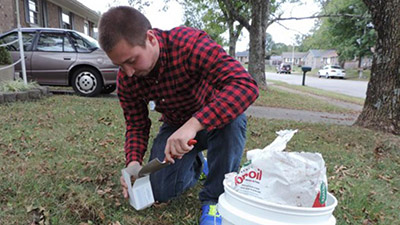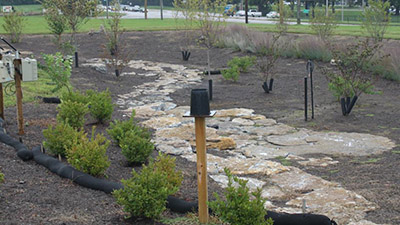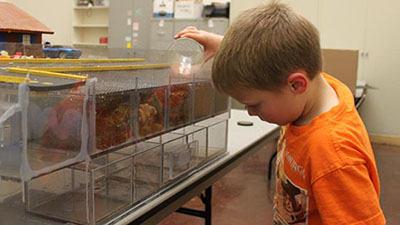Stormwater Management
Stormwater is excess water from rainfall and snowmelts that flows over the ground and does not infiltrate the soil. Human disturbances increase the volume of stormwater generated through the addition of impervious surfaces such as parking lots, rooftops and paved streets. Stormwater is a concern not just in urban areas, but in suburban and agricultural ones as well. As stormwater runoff flows over the land or impervious surfaces, it picks up and transports trash and debris as well as pollutants such as pathogens, nutrients, sediments, heavy metals and chemicals to waterbodies, which can adversely impact water quality. My extension and research efforts focus on methods to reduce the impacts of stormwater.
Download Stormwater Management Logic Model (PDF)
Urban Curve Numbers
 When it rains, water largely follows three paths: 1) it infiltrates into the ground, 2) it evapotranspirates, or 3) it flows over the ground to low points (e.g. stormwater inlets, streams). When rainfall flows over the ground, it is termed stormwater. As we urbanize an area (e.g. construct new neighborhoods), we influence these paths by reducing the amount of pervious area (places where water can soak into the ground) and increasing the amount of impervious area (places where water cannot soak into the ground). Examples of pervious surfaces include forests, pastures and lawns, while examples of impervious surfaces include buildings, sidewalks and streets. Urbanization means less water infiltrates and evapotranspirates and more becomes runoff.
When it rains, water largely follows three paths: 1) it infiltrates into the ground, 2) it evapotranspirates, or 3) it flows over the ground to low points (e.g. stormwater inlets, streams). When rainfall flows over the ground, it is termed stormwater. As we urbanize an area (e.g. construct new neighborhoods), we influence these paths by reducing the amount of pervious area (places where water can soak into the ground) and increasing the amount of impervious area (places where water cannot soak into the ground). Examples of pervious surfaces include forests, pastures and lawns, while examples of impervious surfaces include buildings, sidewalks and streets. Urbanization means less water infiltrates and evapotranspirates and more becomes runoff.
To manage stormwater, we first have to estimate how much rainfall will become runoff. One way we estimate the amount of runoff is by using the curve number (CN) methodology developed by the U.S. Department of Agriculture’s Natural Resources Conservation Service or NRCS. CNs are a way of expressing how much rainfall is likely to become runoff. CNs range from 100 to 0 with larger numbers meaning that more rainfall becomes runoff. For example, a CN of 100 means that all of the rainfall has become runoff while a CN of 0 means none of the rainfall became runoff.
CNs are influenced by land use and soil type and condition. Land use refers to the general use of the land (e.g. forest, residential, commercial) and is related to the amount of impervious area. For instance, forests are expected to produce less runoff than a residential neighborhood because forests have less impervious area, meaning more rainfall can soak into the ground. The ability of soil to soak up water is related to the soil’s texture (e.g. sand, silt or clay) and its level of compaction. Soil with a lot of sand will infiltrate more water and at a quicker rate than soil with a lot of clay. Sand particles are large and have lots of open space between the particles, while clay particles are small and have small spaces between the particles. When soil is compacted, the space between the soil particles becomes even smaller meaning less water can infiltrate. Soil compaction occurs during construction when heavy equipment such as dozers and dump trucks are used. Soil compaction also occurs in areas with lots of foot traffic such as parks.
The CNs currently available in engineering design manuals do not consider the effect of soil compaction. In parks, for example, areas with high foot traffic (e.g. paths) are expected to generate more runoff than areas with low levels of foot traffic. Supplying engineers with a better set of CNs will help in the design of structures to control stormwater.
This project is examining the effect of compaction on the soil’s ability to infiltrate by 1) determining the bulk densities for residential lawns as related to age of the residence and hydrologic soil group (HSG), 2) determining representative infiltration rates for residential lawns as related to bulk density, age of the residence and HSG, 3) evaluating the degree to which lab-constructed soil plots mimic in situ infiltration behavior, and 4) using soil plots to determine CNs for a range of bulk densities.
Antibiotic Detection
The U.E. Environmental Protection Agency classifies antibiotics as a contaminant of emerging concern because they are now detected in the environment at higher than expected levels. The risk these antibiotics pose to human and aquatic life is not known; however, the primary concern is that antibiotic-resistant strains of bacteria will develop. Land application of manures, as part of farm nutrient management plans, is one way antibiotics are introduced to the environment. Runoff can subsequently transport these land applied antibiotics to surface and ground waters. One challenge with studies involving antibiotics is the sensitivity and reliability of detection methods. Another is the time required, and hence labor costs, associated with performing these analyses. This project focused on the development of a new methodology to measure antibiotic concentrations in runoff samples.
View Antibiotic Detection Photos
Farm Road Rain Garden (UK Cat’s CATchment)
 A large portion of the University of Kentucky’s Agricultural Campus is located in the headwaters of Wolf Run, which is a 303(d) listed stream. As a holder of an MS4 (municipal separate storm sewer systems) permit, the University of Kentucky through the Environmental Management Department is continually seeking ways to reduce the impacts of UK’s stormwater while educating its residents (e.g. students, staff and faculty). Through a graduate-level low impact development (LID) course taught by Dr. Agouridis, a stormwater management plan was developed for a 9.3 ha subwatershed of the Agricultural Campus. This plan included the conversion of a nonfunctioning detention basin into a rain garden.
A large portion of the University of Kentucky’s Agricultural Campus is located in the headwaters of Wolf Run, which is a 303(d) listed stream. As a holder of an MS4 (municipal separate storm sewer systems) permit, the University of Kentucky through the Environmental Management Department is continually seeking ways to reduce the impacts of UK’s stormwater while educating its residents (e.g. students, staff and faculty). Through a graduate-level low impact development (LID) course taught by Dr. Agouridis, a stormwater management plan was developed for a 9.3 ha subwatershed of the Agricultural Campus. This plan included the conversion of a nonfunctioning detention basin into a rain garden.
After hearing of this plan in the spring of 2013, the Tracy Farmer Institute for Sustainability and the Environment (TFISE) secured funding from University of Kentucky’s Office of Sustainability and the Lexington-Fayette Urban County Government (LFUCG). Working with Dr. Brian Lee and Corey Wilson of the University of Kentucky Landscape Architecture Department, a design was developed in the summer of 2013. With support from the administration in the College of Agriculture, Food and Environment (CAFE), the rain garden was constructed in the fall of 2013 by faculty, staff and students from the Biosystems and Agricultural Engineering Department.
View Farm Road Rain Garden Photos
Instream Trash Collection System
Trash is a pervasive problem all around the world. It continues to flow into streams, rivers, lakes, estuaries and oceans where it negatively impacts habitats. To help curb the influx of trash, cities have used both programs that focus on periodic stream clean ups as well as structures installed at stormwater inlets or outfalls. In some instances, private companies such as Lexmark International (based in Lexington, KY) join the effort. Lexmark wanted to explore the feasibility of installing a system to collect floatable trash from the Cane Run, which is a stream that flows through their property.
The concept of the trash collection system (known as OSCAR) was originally designed and tested by an undergraduate senior design team in the spring of 2013. The work of the team inspired the creation of a quarter-scale prototype with the goal of exploring the feasibility of constructing a full-scale system. Design of the prototype was assisted by EcoGro, Ridgewater, LLC, Stantec Consulting Services Inc., Storm Water Systems, Inc. and Lexington-Fayette Urban County Government (LFUCG)-Division of Water Quality. The prototype was constructed and tested in a 10 ft. by 23 ft. flume in the University of Kentucky’s Biosystems and Agricultural Engineering Hydrology Lab.
View Farm Road Rain Garden Photos
Coca-Cola Rain Garden
 Urbanization increases the volume of stormwater generated through the addition of impervious surfaces such as parking lots, rooftops and paved surfaces. Such increases in imperviousness have led to reduced levels of infiltration, and subsequently increases in peak flows coupled with reductions in groundwater recharge, as runoff is quickly directed to the storm sewer system. The focus on stormwater management is shifting to management strategies that capture and retain via infiltration or rainwater harvesting.
Urbanization increases the volume of stormwater generated through the addition of impervious surfaces such as parking lots, rooftops and paved surfaces. Such increases in imperviousness have led to reduced levels of infiltration, and subsequently increases in peak flows coupled with reductions in groundwater recharge, as runoff is quickly directed to the storm sewer system. The focus on stormwater management is shifting to management strategies that capture and retain via infiltration or rainwater harvesting.
In September 2011, Coca-Cola Enterprises constructed a second rain garden on their Leestown Road bottling facility. This rain garden is approximately 10,000 ft2 and receives runoff from the warehouse roof and parking lot via two 12-inch diameter pipes. Planted in October 2011, the rain garden is dominated by native trees and shrubs. This goal of this project was to conduct a hydrologic characterization of the newly constructed Coca-Cola rain garden.
View Coca-Cola Rain Garden Photos
Stormwater Detectives
 "Do you live in a watershed?” “Does water from toilets go down the same pipes as water from streets?” “Does your behavior impact water quality?” If you live in Lexington, Kentucky, chances are the answer to these questions is “I don’t know” or “No.” As noted by the consultants commissioned by the Lexington-Fayette Urban County Government (LFUCG), “the lack of education [on stormwater issues] is obvious across the board.” This lack of education is a challenge at a time when LFUCG is in the midst of implementing remedial measures as part of a USEPA consent decree.
"Do you live in a watershed?” “Does water from toilets go down the same pipes as water from streets?” “Does your behavior impact water quality?” If you live in Lexington, Kentucky, chances are the answer to these questions is “I don’t know” or “No.” As noted by the consultants commissioned by the Lexington-Fayette Urban County Government (LFUCG), “the lack of education [on stormwater issues] is obvious across the board.” This lack of education is a challenge at a time when LFUCG is in the midst of implementing remedial measures as part of a USEPA consent decree.
Kentucky served as one of the lead states in the development of the Next Generation Science Standards (NGSS). The NGSS serves as an update to the previously used state science standards; now engineering design is included. However, K-12 teachers often lack curriculum to teach engineering design. Both needs – the need for stormwater education and the need for K-12 engineering design based curriculum – created an ideal situation for a pairing. To fulfill this need, an interactive lot-scale stormwater model and five lesson plans were developed to teach primarily 3rd-5th graders about stormwater issues and how to define, design and test possible stormwater management solutions. The effectiveness of the lesson plans and interactive model was tested on students in the Cassidy Colts afterschool program (IRB no. 14-0195-X4B). Evaluation was done through pre- and post-surveys as well as classroom observations by two educators. Results showed that lesson plans and the interactive model were successful in teaching stormwater issues and engineering design while stimulating curiosity and enthusiasm.
